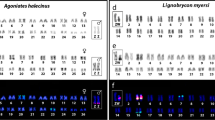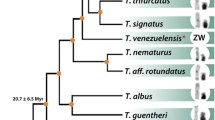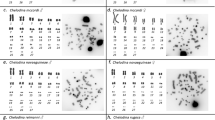Abstract
The Neotropical fish, Hoplias malabaricus, is one of the most cytogenetically studied fish taxon with seven distinct karyomorphs (A–G) comprising varying degrees of sex chromosome differentiation, ranging from homomorphic to highly differentiated simple and multiple sex chromosomes. Therefore, this fish offers a unique opportunity to track evolutionary mechanisms standing behind the sex chromosome evolution and differentiation. Here, we focused on a high-resolution cytogenetic characterization of the unique XX/XY1Y2 multiple sex chromosome system found in one of its karyomorphs (G). For this, we applied a suite of conventional (Giemsa-staining, C-banding) and molecular cytogenetic approaches, including fluorescence in situ hybridization FISH (with 5S and 18S rDNAs, 10 microsatellite motifs and telomeric (TTAGGG) n sequences as probes), comparative genomic hybridization (CGH), and whole chromosome painting (WCP). In addition, we performed comparative analyses with other Erythrinidae species to discover the evolutionary origin of this unique karyomorph G-specific XY1Y2 multiple sex chromosome system. WCP experiments confirmed the homology between these multiple sex chromosomes and the nascent XX/XY sex system found in the karyomorph F, but disproved a homology with those of karyomorphs A–D and other closely related species. Besides, the putative origin of such XY1Y2 system by rearrangements of several chromosome pairs from an ancestral karyotype was also highlighted. In addition, clear identification of a male-specific region on the Y1 chromosome suggested a differential pattern of repetitive sequences accumulation. The present data suggested the origin of this unique XY1Y2 sex system, revealing evidences for the high level of plasticity of sex chromosome differentiation within the Erythrinidae.







Similar content being viewed by others
References
Almeida-Toledo LF, Foresti F (2001) Morphologically differentiated sex chromosomes in neotropical freshwater fish. Genetica 111:91–100. https://doi.org/10.1023/A:1013768104422
Arai R (2011) Fish karyotypes: a check list. 1st edn. Springer, Tokyo
Bachtrog D, Charlesworth B (2001) Towards a complete sequence of the human Y chromosome. Genome Biol 2:1–5. https://doi.org/10.1186/gb-2001-2-5-reviews1016
Badenhorst D, Stanyon R, Engstrom T, Valenzuela N (2013) A ZZ/ZW microchromosome system in the spiny softshell turtle, Apalone spinifera, reveals an intriguing sex chromosome conservation in Trionychidae. Chromosom Res 21:137–147. https://doi.org/10.1007/s10577-013-9343-2
Barros AV, Wolski MAV, Nogaroto V, Almeida MC, Moreira-Filho O, Vicari MC (2017) Fragile sites, dysfunctional telomere and chromosome fusions: what is 5S rDNA role? Gene 608:20–27. https://doi.org/10.1016/j.gene.2017.01.013
Bertollo LAC (2007) Chromosome evolution in the Neotropical Erythrinidae fish family: an overview. In: Pisano E, Ozouf-Costaz C, Foresti F, Kapoor BG (eds) Fish cytogenetics. Science Publishers, Enfield, pp 195–211
Bertollo LAC, Takahashi CS, Moreira-Filho O (1983) Multiple sex chromosomesin the genus Hoplias (Pisces, Erythrinidae). Cytologia 48:1–12. https://doi.org/10.1508/cytologia.48.1
Bertollo LAC, Fontes MS, Fenocchio AS, Cano J (1997) The X1X2Y sex chromosome system in the fish Hoplias malabaricus I. G-, C- and chromosome replication banding. Chromosome Res 5:493–499.
Bertollo LAC, Born GG, Dergam JA, Fenocchio AS, Moreira-Filho O (2000) A biodiversity approach in the neotropical Erythrinidae fish, Hoplias malabaricus. Karyotypic survey, geographic distribution of cytotypes and cytotaxonomic considerations. Chromosom Res 8:603–613. https://doi.org/10.1023/A:1009233907558
Bertollo LAC, Moreira-Filho O, Cioffi MB (2015) Direct chromosome preparations from freshwater teleost fishes. In: Ozouf-Costaz C, Pisano E, Foresti F, Almeida Toledo LF (eds) Fish techniques, Ray-Fin Fishes and Chondrichthyans. CRC Press, Boca Raton, pp 21–26
Bitencourt JA, Sampaio I, Ramos RTC, Vicari MR, Affonso PRAM (2016) First report of sex chromosomes in Achiridae (Teleostei: Pleuronectiformes) with inferences about the origin of the multiple X1X1X2X2/X1X2Y system and dispersal of ribosomal genes in Achirus achirus. Zebrafish 14:90–95. https://doi.org/10.1089/zeb.2016.1333
Blanco DR, Lui RL, Bertollo LAC, Diniz D, Moreira Filho O (2010a) Characterization of invasive fish species in a river transposition region: evolutionary chromosome studies in the genus Hoplias (Characiformes, Erythrinidae). Rev Fish Biol Fish 20:1–8. https://doi.org/10.1007/s11160-009-9116-3
Blanco DR, Lui RL, Bertollo LAC, Margarido VP, Moreira-Filho O (2010b) Karyotypic diversity between allopatric populations of the group Hoplias malabaricus (Characiformes: Erythrinidae): evolutionary and biogeographic considerations. Neotrop Ichthyol 8:361–368. https://doi.org/10.1590/S1679-62252010000200015
Blanco DR, Lui RL, Vicari MR, Bertollo LAC, Moreira-Filho O (2011) Comparative cytogenetics of giant trahiras Hoplias aimara and H. intermedius (Characiformes, Erythrinidae): chromosomal characteristics of minor and major ribosomal DNA and cross-species repetitive centromeric sequences mapping differ among morphologically identical karyotypes. Cytogenet Genome Res 132:71–78. https://doi.org/10.1159/000320923
Blanco DR, Vicari MR, Lui RL, Artoni RF, de Almeida MC, Traldi JB, Margarido VP (2014) Origin of the X1X1X2X2/X1X2Y sex chromosome system of Harttia punctata (Siluriformes, Loricariidae) inferred from chromosome painting and FISH with ribosomal DNA markers. Genetica 142:119–126. https://doi.org/10.1007/s10709-014-9759-4
Born GG, Bertollo LAC (2000) An XX/XY sex chromosome system in a fish species, Hoplias malabaricus, with a polymorphic NOR-bearing X chromosome. Chromosom Res 8:111–118. https://doi.org/10.1023/A:1009238402051
Chalopin D, Volff J-N, Galiana D, Anderson JL, Schartl M (2015) Transposable elements and early evolution of sex chromosomes in fish. Chromosom Res 23:545–560. https://doi.org/10.1007/s10577-015-9490-8
Charlesworth D, Charlesworth B, Marais G (2005) Steps in the evolution of heteromorphic sex chromosomes. Heredity 95:118–128. https://doi.org/10.1038/sj.hdy.6800697
Charlesworth D, Mank J (2010) The birds and the bees and the flowers and the trees: lessons from genetic mapping of sex determination in plants and animals. Genetics 186:9–31. https://doi.org/10.1534/genetics.110.117697
Charlesworth B, Wall JD (1999) Inbreeding, heterozygote advantage and the evolution of neo-X and neo-Y sex chromosomes. Proc R Soc Lond B 266:51–56. https://doi.org/10.1098/rspb.1999.0603
Cioffi MB, Martins C, Centofante L, Jacobina U, Bertollo LAC (2009) Chromosomal variability among allopatric populations of Erythrinidae fish Hoplias malabaricus: mapping of three classes of repetitive DNAs. Cytogenet Genome Res 125:132–141. https://doi.org/10.1159/000227838
Cioffi MB, Bertollo LAC (2010) Initial steps in XY chromosome differentiation in Hoplias malabaricus and the origin of an X1X2Y sex chromosome system in this fish group. Heredity 105:554–561. https://doi.org/10.1038/hdy.2010.18
Cioffi MB, Martins C, Bertollo LAC (2010a) Chromosome spreading of associated transposable elements and ribosomal DNA in the fish Erythrinus erythrinus. Implications for genome change and karyoevolution in fish. BMC Evol Biol 10:271. https://doi.org/10.1186/1471-2148-10-271
Cioffi MB, Martins C, Vicari MR, Rebordinos L, Bertollo LAC (2010b) Differentiation of the XY sex chromosomes in the fish Hoplias malabaricus (Characiformes, Erythrinidae). Unusual accumulation of repetitive sequences on the X chromosome. Sex Dev 4:176–185. https://doi.org/10.1159/000309726
Cioffi MB, Camacho JPM, Bertollo LAC (2011) Repetitive DNAs and differentiation of sex chromosomes in neotropical fishes. Cytogenet Genome Res 132:188–194. https://doi.org/10.1159/000322058
Cioffi MB, Molina WF, Artoni RF, Bertollo LAC (2012) Chromosomes as tools for discovering biodiversity—the case of Erythrinidae fish family. In: Tirunilai P (ed) Recent trends in cytogenetic studies—methodologies and applications. InTech Publisher, pp 125–146
Cioffi MB, Liehr T, Trifonov V, Molina WF, Bertollo LAC (2013) Independent sex chromosome evolution in lower vertebrates: a molecular cytogenetic overview in the Erythrinidae fish family. Cytogenet Genome Res 141:186–194. https://doi.org/10.1159/000354039
Cocca E, Petraccioli A, Morescalchi MA, Odierna G, Capriglione T (2015) Laser microdissection-based analysis of the Y sex chromosome of the Antarctic fish Chionodraco hamatus (Notothenioidei, Channichthyidae). Comp Cytogenet 9:1–15. https://doi.org/10.3897/CompCytogen.v9i1.8731
Devlin RH, Nagahama Y (2002) Sex determination and sex differentiation in fish: an overview of genetic, physiological, and environmental influences. Aquaculture 208:191–364. https://doi.org/10.1016/S0044-8486(02)00057-1
Ezaz T, Valenzuela N, Grützner F, Miura I, Georges A, Burke RL, Graves JAM (2006) An XX/XY sex microchromosome system in a freshwater turtle, Chelodina longicollis (Testudines: Chelidae) with genetic sex determination. Chromosom Res 14:139–150. https://doi.org/10.1007/s10577-006-1029-6
Ferreira IA, Bertollo LAC, Martins C (2007) Comparative chromosome mapping of 5S rDNA and 5SHindIII repetitive sequences in Erythrinidae fishes (Characiformes) with emphasis on the Hoplias malabaricus “species complex”. Cytogenet Genome Res 118:78–83. https://doi.org/10.1159/000106445
Ferreira M, Garcia C, Matoso DA, de Jesus IS, Feldberg E (2016) A new multiple sex chromosome system X1X1X2X2/X1Y1X2Y2 in Siluriformes: cytogenetic characterization of Bunocephalus coracoideus (Aspredinidae). Genetica 144:591–599. https://doi.org/10.1007/s10709-016-9927-9
Freitas NL, Al-Rikabi ABH, Bertollo LAC, Ezaz T, Yano CF, de Oliveira EA, Hatanaka T et al (2017) Early stages of XY sex chromosomes differentiation in the fish Hoplias malabaricus (Characiformes, Erythrinidae) revealed by DNA repeats accumulation. Curr Genomics. https://doi.org/10.2174/1389202918666170711160528
Ijdo JW, Wells RA, Baldini A, Reeders ST (1991) Improved telomere detection using a telomere repeat probe (TTAGGG)n generated by PCR. Nucleid Acids Res 19:4780
Kawai A, Nishida-Umehara C, Ishijima J, Tsuda Y, Ota H, Matsuda Y (2007) Different origins of bird and reptile sex chromosomes inferred from comparative mapping of chicken Z-linked genes. Cytogenet Genome Res 117:92–102. https://doi.org/10.1159/000103169
King M (1993) Species evolution: the role of chromosome change. University Press, Cambridge
Kitano J, Peichel CL (2012) Turnover of sex chromosomes and speciation in fishes. Environ Biol Fish 94:549–558. https://doi.org/10.1007/s10641-011-9853-8
Kejnovsky E, Hobza R, Cermak T, Z Kubat Z, Vyskot B (2009) The role of repetitive DNA in structure and evolution of sex chromosomes in plants. Heredity 102:533–541. https://doi.org/10.1038/hdy.2009.17
Kejnovský E, Michalovová M, Šteflova P, Kejnovská I, Manzano S, Hobza R, Kubát Z (2013) Expansion of microsatellites on evolutionary young Y chromosome. PLoS One 8:e45519. https://doi.org/10.1371/journal.pone.0045519
Kraemer C, Schmidt ER (1993) The sex determining region of Chironomus thummi is associated with highly repetitive DNA and transposable elements. Chromosoma 102:553–562. https://doi.org/10.1007/BF00368348
Kubát Z, Hobza R, Vyskot B, Kejnovsky E (2008) Microsatellite accumulation in the Y chromosome of Silene Latifolia. Genome 51:350–356. https://doi.org/10.1139/G08-024
Levan A, Fredga K, Sandberg AA (1964) Nomenclature for centromeric position on chromosomes. Hereditas 52:201–220. https://doi.org/10.1111/j.1601-5223.1964.tb01953.x
Machado TC, Pansonato-Alves JC, Pucci MB, Nogaroto V, Almeida MC, Oliveira C, Foresti F et al (2011) Chromosomal painting and ZW sex chromosomes differentiation in Characidium (Characiformes, Crenuchidae). BMC Genet 12:65. https://doi.org/10.1186/1471-2156-12-65
Mank JE, Avise JC (2009) Evolutionary diversity and turn-over of sex determination in teleost fishes. Sex Dev 3:60–67. https://doi.org/10.1159/000223071
Mank JE, Promislow DEL, Avise JC (2006) Evolution of alternative sex-determining mechanisms in teleost fishes. Biol J Linn Soc 87:83–93. https://doi.org/10.1098/rspb.2005.3334
Martins C (2007) Chromosomes and repetitive DNAs: a contribution to the knowledge of the fish genome. In: Pisano E, Ozouf-Costaz C, Foresti F, Kapoor BG (eds) Fish cytogenetics. Science Publishers, Enfield, pp 421–453
Martins C, Ferreira IA, Oliveira C, Foresti F, Galetti Jr PM (2006) A tandemly repetitive centromeric DNA sequence of the fish Hoplias malabaricus (Characiformes: Erythrinidae) is derived from 5S rDNA. Genetica 127:133–141. https://doi.org/10.1007/s10709-005-2674-y
Martins NF, Bertollo LAC, Troy WP, Feldberg E, Valentin FCS, Cioffi MB (2013) Differentiation and evolutionary relationships in Erythrinus erythrinus (Characiformes, Erythrinidae): comparative chromosome mapping of repetitive sequences. Rev Fish Biol Fish 23:261–269. https://doi.org/10.1007/s11160-012-9292-4
Noronha RCR, Nagamachi CY, O’Brien PCM, Ferguson-Smith MA, Pieczarka JCN (2009) Neo-XY body: an analysis of XY1Y2 meiotic behavior in Carollia (Chiroptera, Phyllostomidae) by chromosome painting. Cytogenet Genome Res 124:37–43. https://doi.org/10.1159/000200086
Ohno S (1967) Sex chromosomes and sex-linked genes. Springer-Verlag, Berlin. Heidelberg. New York
Oliveira C, Almeida-Toledo LF, Foresti F (2007) Karyotypic evolution in Neotropical fishes. In: Pisano E, Ozouf-Costaz C, Foresti F, Kapoor BG (eds) Fish cytogenetics. Science Publishers, Enfield, pp 111–164
Oliveira C, Foresti F, Hilsdorf AWS (2009) Genetics of neotropical fish: from chromosomes to populations. Fish Physiol Biochem 35:81–100. https://doi.org/10.1007/s10695-008-9250-1
Oliveira RR, Feldberg E, dos Anjos MB, Zuanon J (2008) Occurrence of multiple sexual chromosomes (XX/XY1Y2 and Z1Z1Z2Z2/Z1Z2W1W2) in catfishes of the genus Ancistrus (Siluriformes: Loricariidae) from the Amazon basin. Genetica 134:243–249. https://doi.org/10.1007/s10709-007-9231-9
Oyakawa OT (2003) Family Erythrinidae. In: Reis RE, Kullander SO, Ferraris Jr CJ (eds) Check list of the freshwater fishes of South and Central America. Edipucrs, Porto Alegre, pp 238–240
Oyakawa OT, Mattox GMT (2009) Revision of the Neotropical trahiras of the Hoplias lacerdae species-group (Ostariophysi: Characiformes: Erythrinidae) with descriptions of two new species. Neotrop Ichthyol 7:117–140
Palacios-Gimenez OM, Castillo ER, Marti DA, Cabral-de-Mello DC (2013) Tracking the evolution of sex chromosome systems in Melanoplinae grasshoppers through chromosomal mapping of repetitive DNA sequences. BMC Evol Biol 13:167. https://doi.org/10.1186/1471-2148-13-167
Parise-Maltempi PP, Martins C, Oliveira C, Foresti F (2007) Identification of a new repetitive element in the sex chromosomes of Leporinus elongatus (Teleostei: Characiformes: Anostomidae): new insights into the sex chromosomes of Leporinus. Cytogenet Genome Res 116:218–223. https://doi.org/10.1159/000098190
Pennell MW, Kirkpatrick M, Otto SP, Vamosi JC, Peichel CL, Valenzuela N, Kitano J (2015) Y fuse? Sex chromosome fusions in fishes and reptiles. PLoS Genet 11:e1005237. https://doi.org/10.1371/journal. pgen.1005237
Poltronieri J, Marquioni V, Bertollo LAC, Kejnovsky E, Molina WF, Liehr T, Cioffi MB (2014) Comparative chromosomal mapping of microsatellites in Leporinus species (Characiformes, Anostomidae): unequal accumulation on the W chromosomes. Cytogenet Genome Res 142:40–45. https://doi.org/10.1159/000355908
Pokorná M, Kratochvíl L, Kejnovský E (2011) Microsatellite distribution on sex chromosomes at different stages of heteromorphism and heterochromatinization in two lizard species (Squamata: Eublepharidae: Coleonyx elegans and Lacertidae: Eremias velox). BMC Genet 12:90. https://doi.org/10.1186/1471-2156-12-90
Pokorná M, Rábová M, Ráb P, Ferguson-Smith MA, Rens W, Kratochvíl L (2010) Differentiation of sex chromosomes and karyotypic evolution in the eye-lid geckos (Squamata: Gekkota: Eublepharidae), a group with different modes of sex determination. Chromosom Res 18:809–820. https://doi.org/10.1007/s10577-010-9154-7
Reed KM, Phillips RB (1997) Polymorphism of the nucleolus organizer region (NOR) on the putative sex chromosomes of Arctic char (Salvelinus alpinus) is not sex related. Chromosom Res 5:221–227. https://doi.org/10.1023/A:101841141
Rosa R, Laforga Vanzela AL, Rubert M, Martins-Santos IC, Giuliano-Caetano L (2009) Differentiation of Y chromosome in the X1X1X2X2/X1X2Y sex chromosome system of Hoplias malabaricus (Characiformes, Erythrinidae). Cytogenet Genome Res 127:54–60. https://doi.org/10.1159/000269736
Sambrook J, Russell DW (2001) Molecular cloning: a laboratory manual, 3rd edn. Cold Spring Harbor, New York
Santos U, Völcker CM, Belei FA, Cioffi MB, Bertollo LAC, Paiva SR, Dergam JA (2009) Molecular and karyotypic phylogeography in the Neotropical Hoplias malabaricus (Erythrinidae) fish in eastern Brazil. J Fish Biol 75:2326–2343. https://doi.org/10.1111/j.1095-8649.2009.02489.x
Scacchetti PC, Utsunomia R, Pansonato-Alves JC, da Costa Silva GJ, Vicari MR, Artoni RF, Oliveira C (2015) Repetitive DNA sequences and evolution of ZZ/ZW sex chromosomes in Characidium (Teleostei: Characiformes). PLoS One 10:e0137231. https://doi.org/10.1371/journal.pone.0137231
Schartl M, Schmid M, Nanda I (2016) Dynamics of vertebrate sex chromosome evolution: from equal size to giants and dwarfs. Chromosoma 125:553–571. https://doi.org/10.1007/s00412-015-0569-y
Sember A, Bohlen J, Šlechtová V, Altmanová M, Symonová R, Ráb P (2015) Karyotype differentiation in 19 species of river loach fishes (Nemacheilidae, Teleostei): extensive variability associated with rDNA and heterochromatin distribution and its phylogenetic and ecological interpretation. BMC Evol Biol 15:251. https://doi.org/10.1186/s12862-015-0532-9
Sumner AT (1972) A simple technique for demonstrating centromeric heterochromatin. Exp Cell Res 75:304–306. https://doi.org/10.1016/0014-4827(72)90558-7
Symonová R, Sember A, Majtánová Z, Ráb P (2015) Characterization of fish genomes by GISH and CGH. In: Ozouf-Costaz C, Pisano E, Foresti F, Almeida-Toledo LF (eds) Fish cytogenetic techniques (Chondrichthyans and Teleosts). CRC Press, Inc., Enfield, pp 118–131
Terencio ML, Schneider CH, Gross MC, Vicari MR, Farias IP, Passos KB, Feldberg E (2013) Evolutionary dynamics of repetitive DNA in Semaprochilodus (Characiformes, Prochilodontidae): a fish model for sex chromosome differentiation. Sex Dev 7:325–333. https://doi.org/10.1159/000356691
Wang X, Zhang Q, Ren J, Jiang Z, Wang C, Zhuang W, Zhai T (2009) The preparation of sex-chromosome-specific painting probes and construction of sex chromosome DNA library in half-smooth tongue sole (Cynoglossus semilaevis). Aquaculture 297:78–84. https://doi.org/10.1016/j.aquaculture.2009.09.020
Willhoeft U, Franz G (1996) Identification of the sex-determining region of the Ceratitis Capitata Y chromosome by deletion mapping. Genetics 144:737–745
Woram RA, Gharbi K, Sakamoto T, Hoyheim B, Holm L-E, Naish K, McGowan C et al (2003) Comparative genome analysis of the primary sex-determining locus in salmonid fishes. Genome Res 13:272–280. https://doi.org/10.1101/gr.578503
Xu D, Lou B, Bertollo LAC, Cioffi MB (2013) Chromosomal mapping of microsatellite repeats in the rock bream fish Oplegnathus fasciatus, with emphasis of their distribution in the neo-Y chromosome. Mol Cytogenet 6:12. https://doi.org/10.1186/1755-8166-6-12
Yang F, Trifonov V, Ng BL, Kosyakova N, Carter NP (2009) Generation of paint probes by flowsorted and microdissected chromosomes. In: Liehr T (ed) Fluorescence in situ hybridization (FISH)—application guide, 2nd edn. Springer, Berlin, pp 35–52
Yano CF, Bertollo LAC, Cioffi MB (2017a) Fish-FISH: molecular cytogenetics in fish species. In: Liehr T (ed) Fluorescence in situ hybridization (FISH)—application guide, 2nd edn. Springer, Berlin, pp 429–444
Yano CF, Bertollo LAC, Ezaz T, Trifonov V, Sember A, Liehr T, Cioffi MB (2017b) Highly conserved Z and molecularly diverged W chromosomes in the fish genus Triportheus (Characiformes, Triportheidae). Heredity 118:276–283. https://doi.org/10.1038/hdy.2016.83
Zwick MS, Hanson RE, McKnight TD, Islam-Faridi MN, Stelly DM, Wing RA, Price HJ (1997) A rapid procedure for the isolation of C0t-1 DNA from plants. Genome 40:138–142. https://doi.org/10.1139/g97-020
Acknowledgements
We would like to thank Mr. Valdivino Pereira da Silva (Renascer farm) for helping during the sampling process.
Funding
This study was supported by Conselho Nacional de Desenvolvimento Científico e Tecnológico - CNPq (Proc. Nos. 304992/2015-1, 306896/2014-1, and 152105/2016-6) and Fundação de Amparo à Pesquisa do Estado de São Paulo- FAPESP (Proc. No. 2016/21411-7) and further by the projects EXCELLENCE CZ.02.1.01/0.0/0.0/15_003/0000460 OP RDE and RVO: 67985904.
Author information
Authors and Affiliations
Corresponding author
Ethics declarations
The experiments followed ethical and anesthesia conducts, in accordance with the Ethics Committee on Animal Experimentation of the Universidade Federal de São Carlos (Process Number CEUA 1853260315).
Conflict of interest
The authors declare that they have no conflict of interest.
Informed consent
Informed consent was obtained from all individual participants included in the study.
Additional information
Both Ezequiel Aguiar de Oliveira and Alexandr Sember will share the first authorship of this manuscript.
Rights and permissions
About this article
Cite this article
de Oliveira, E.A., Sember, A., Bertollo, L.A.C. et al. Tracking the evolutionary pathway of sex chromosomes among fishes: characterizing the unique XX/XY1Y2 system in Hoplias malabaricus (Teleostei, Characiformes). Chromosoma 127, 115–128 (2018). https://doi.org/10.1007/s00412-017-0648-3
Received:
Revised:
Accepted:
Published:
Issue Date:
DOI: https://doi.org/10.1007/s00412-017-0648-3




